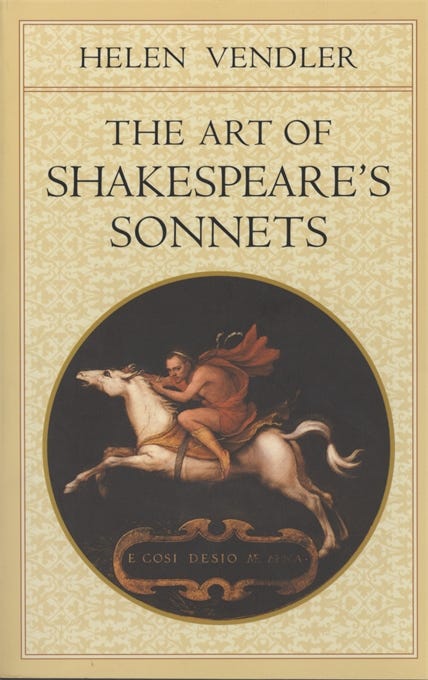The Art of Shakespeare’s Sonnets
In The Art of Shakespeare’s Sonnets, Helen Vendler, widely regarded as our most accomplished interpreter of poetry, serves as an incomparable guide to some of the best-loved poems in the English language. In detailed commentaries on Shakespeare’s 154 sonnets, Vendler reveals previously unperceived imaginative and stylistic features of the poems, pointing out not only new levels of import in particular lines, but also the ways in which the four parts of each sonnet work together to enact emotion and create dynamic effect. The commentaries offer fresh perspectives on the individual poems, and, taken together, provide a full picture of Shakespeare’s techniques as a working poet. With the help of Vendler’s acute eye, we gain an appreciation of “Shakespeare’s elated variety of invention, his ironic capacity, his astonishing refinement of technique, and, above all, the reach of his skeptical imaginative intent.” Here is a look at Shakespeare’s most famous sonnet.

Shall I compare thee to a summer’s day?
Thou art more lovely and more temperate:
Rough winds do shake the darling buds of May,
And summer’s lease hath all too short a date;
Sometime too hot the eye of heaven shines,
And often is his gold complexion dimmed;
And every fair from fair sometime declines,
By chance or nature’s changing course untrimmed:
But thy eternal summer shall not fade,
Nor lose possession of that fair thou ow’st,
Nor shall Death brag thou wand’rest in his shade,
When in eternal lines to time thou grow’st.
So long as men can breathe or eyes can see,
So long lives this, and this gives life to thee.
To come, as a commentator, on this — the most familiar of the poems and the most indisputably Shakespearean, Elizabethan, and sonnet-like — is both a balm and a test: what remains to be said? In its proffering of love and fame, it stands with sonnet 12, free of that fear of the beloved’s corruption which enters the sequence at least as early as 24 (Mine eye hath played the painter). There are many things to praise here, but I will use this poem as an instance of one of Shakespeare’s greatest compositional powers — his capacity to confer greater and greater mental scope on any whim of the imagination, enacting that widening gradually, so that the experience of reading a poem becomes the experience of pushing back the horizons of thought.
Many of Shakespeare’s sonnets are constructed, like this one, on a very common cultural contrast (here, the temporality of physical existence and the eternity of verse). But where another poet might begin by showing his hand in a topic sentence, saying, “Things mortal pass away, but rhymes remain,” such is not Shakespeare’s way. He begins with a trifle — a youth and a day and an apparent whim of the inventive mind:
Shall I compare thee to a summer’s day?
It is gentle, light, innocuous, dulcet; and its expansion seems at first dulcet, too: lovely, temperate — these are self-reflexive adjectives for a wooing song. Even the rough winds leave the darling buds on the branches, merely shake[n], a danger evaded; and it is only with the short date on summer’s lease (Thy end is truth’s and beauty’s doom and date; sonnet 14) that a somber quality enters, and we realize that from the lovely day we have come far, to the end of a season. A quick graph of lines 1–12 will show their inexorable widening of scope and deepening of gravity:
thee and a day (1–2)
a month (May) (3)
end of a season (summer) (4)
the eye of heaven (sun, ordainer of seasons) (5)
the weather itself (hot or dimmed) (6)
the decline of every beauty (7)
the operations of chance (8)
the changing course of nature (8)
an eternal summer (9)
an unfading fair[ness] (9–10)
the foiling of Death (11)
eternal art (12)
It is a long way from an apparently fanciful natural simile to eternal art, and yet Shakespeare traverses it in twelve lines. Only in the couplet does he concede that art has human perpetuity rather than transcendent eternity.
One can imagine hundreds of ways of proceeding for a poem beginning Shall I compare thee to X? One evident structure could be to continue by saying Or rather should I compare thee to Y? or Z? with a list of pretty things, a way of proceeding that Shakespeare will satirize in 21 (So is it not with me) and 130 (My mistress’ eyes are nothing like the sun). It is only when we see that such a list is not forthcoming in 18 that we realize that such a listing has already taken place. Shall I compare thee to a rose? Too thorny. To a dawn? Too brief. To a spring day? Too uncertain. What is the most beautiful thing, the summum bonum, in an (English) world? A summer’s day. And then we see that by taking the pinnacle of perfection as his standard of comparison, the poet/lover, convinced that nothing can outstrip or even equal his beloved, must begin to denigrate his perfect metaphor: ah, but a summer’s day could have a wind, could be hot, could be cloudy. Its very inhabitants, the rosebuds and the sun, which reminded him of the beloved in the first place, can be endangered or can play him false; and, once started, the process of impugning the perfect cannot be arrested until it runs the whole gamut of decline. As one uncertainty tumbles into another, and as uncertainty wrecks itself in misfortune, we see Shakespeare’s tendency to concatenation (cf. 129) in full spate, mimicked phonemically by chance or nature’s changing course. Other concatenations: shake, short, shines, complexion, shade; day, darling, dimmed, declines, Death; lovely, lease, lose, lines, long, lives, life.
Although the ostensible (and perhaps actual) structure of the sonnet is one of contrast (the mutable versus the eternal; chance or nature’s changing course versus eternal summer in eternal lines), the principle of expansive claim is as strong, structurally, as the principle of contrast. Such, at least, is the original triumphant tonality of the sestet: But thy eternal summer shall not fade . . . Nor shall Death brag. But there is an urbanity, and tempered measure, about the subsequent couplet that makes the end of the poem not so far from the beginning as it would have been had it ended on such a note of apparently pure triumph. Even in Q3, the triumph is tempered: the eternity of the beloved is paradoxically expressed in intrinsically limited seasonal terms, as an everlasting brevity (eternal summer) and the eternal lines grow to time (i.e., within duration). The couplet carries the tempering of triumph yet further: the lines last only so long as there exist, among the men who can breathe, eyes that can see this poem. Only so long will the putatively eternal lines live in time. The urbanity of the iambic tune of the couplet
So long as men can breathe or eyes can see,
So long lives this, and this gives life to thee
is itself temperate, moderated by the evenness of the clock that tells the time, not driven by the wind of prophecy. Even the prophetic tense — shall not fade, shall not brag — gives way to a a possibility (can) deceptively ecpressed in two rhyming present-tense verbs, lives and gives: this lives, this gives life. The temperate has proved the temporal, in Shakespeare’s (correct) etymology, and to be more temperate than natural loveliness one must escape natural chance and the cycle of natural change altogether. It is to Shakespeare’s eternal credit that he invented the eternal season growing to time in eternal lines potentiated only by a (finally finite) succession of human readers, thereby entwining, in perpetual paradox, the brevity of love, temporal truth, and the fragile strength of art before its extinction. It is probably needless to praise him again for what has so often been praised, the noticing of the particular (the wind-shaken buds) in such general yet observant terms that they spring to every reader’s mind every May in the temperate zones. And it is probably just as unnecessary to remark his ability to step through time:
Sometime too hot the eye of heaven shines,
And often is his gold complexion dimmed,
And every fair from fair sometime declines,
By chance or nature’s changing course untrimmed.
From one sun to every fair, from sometimes to often, from dimmed to untrimmed — by one great agency or another, things are undone: it is the pace of Necessity itself.
It should be noticed that in the Quarto spelling, lines and liues differ only by the turning upside-down of one letter, making a quasi-punning Couplet Tie.
